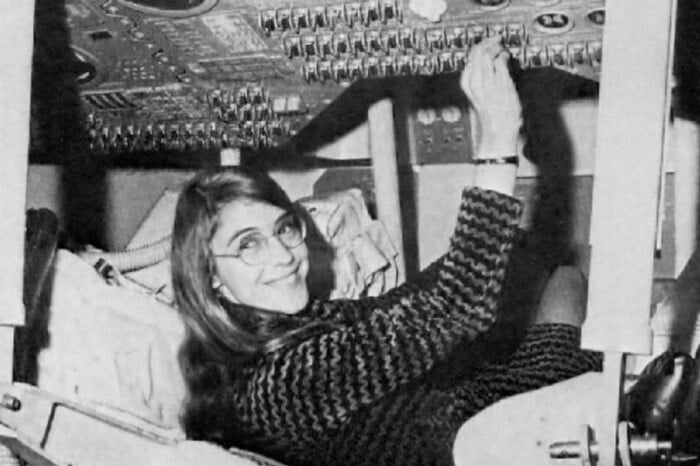Picture an early eighteenth-century setting, one with extravagant garments and horse-drawn carriages. A group of lords and ladies gather in a small wooden house in London, discussing industrialization as their faces are illuminated by candlelight.
Imagine that one of them created the first machine algorithm.
Would it have been the lord or the lady?
Now, flash forward 130 years to the early days of NASA. They are landing people on the moon with computers that take up entire office floors but only have 72 kilobytes of computer memory.
Was it a man or woman who led the team that wrote the code for these rocket launches?
The correct answer to both is a woman. In 1842, Ada Lovelace, the daughter of the famous poet Lord Byron, was credited as the world’s first programmer for her notes on Charles Babbage’s Analytical Engine. In the 1960s, Margaret Hamilton coined the term software engineering as she led the team that landed, Neil Armstrong, on the moon.
Despite women’s fundamental role in creating software engineering, their contributions remain a footnote in history, and they are still vastly underrepresented in the tech industry. To further the gender gap conversation, Celential.ai used its proprietary talent graph and AI algorithms to uncover critical metrics that illustrate the severity of this underrepresentation.
In this article, we discuss what these metrics tell us about the gender gap in tech and how women of the past offer inspiration for the future.
For all of the info on the representation of women in various leadership levels across major cities and the largest tech companies, you can read the full report here.
A brief history of women in software engineering
Mathematicians used simple calculators from pebbles to abaci to mechanical multiplication machines throughout pre-and early modern history.
However, it wasn’t until the 19th century, when Ada Lovelace grasped the enormous potential of the theoretical Analytical Engine to go far beyond rote calculation, that computer programming was born.
Lovelace accurately theorized that computers could be used to solve problems involving not just numbers but all logical processes, from music to weaving.
In 1844, Lovelace published the first-ever computer program — a century before the first working computer ever existed.

Jumping ahead one hundred years later to World War II, Nazi Germany was locked in a deadly struggle with the Allies. They encrypted their communications with the supposedly invincible Enigma machine.
Enigma was succeeded by the even more devilishly complicated Lorenz machine, with its 12 rotating wheels allowing for five billion code combinations. To reverse-engineer the encryption, British codebreakers, led by Alan Turing and Joan Clarke, invented Colossus in 1943, the world’s first programmable computer.
The Women’s Royal Naval Service operated Colossus. The “wrens”, as they were called, successfully operated Colossus to decipher Nazi messages, saving countless Allied lives.

Clare Evans recounts in her book “Broad Band” that in this era, “the term ‘girl’ was used interchangeably with ‘computer’. One member of the Applied Mathematics Panel […] ballparked a unit of ‘kilogirl’ energy as being equivalent to roughly a thousand hours of computing labor.”
After the war, many private companies employed women as programmers, eager to take advantage of the possibilities of computation.
The work these women did was unsurprisingly undervalued, underpaid, and unappreciated. Women were expected to stop work immediately upon starting a family, and many left the workforce.

Elsie Shutt, a programmer hired by Raytheon in 1953, recalls that computer programmers were roughly half and half men and women even after the war, reminiscing, “And it really amazed me that these men were programmers because I thought it was women’s work!”
Despite these obstacles, women continued to make vital contributions to the field of software engineering.
Grace Hopper advanced the field tremendously in the 1950s with her realization that the use of English syntax such as “if”, “then,” and “while” could make code far more user-friendly and readable.

Hopper also invented “Flow-Matic”, the first programming language that resembled English. Flow-Matic provided the basis for COBOL, a language still used worldwide today.
Grace Hopper’s efforts to democratize computer programming and make it more accessible were key to the skyrocketing importance and usage of this technology.
In the sixties and seventies, women such as Katherine Johnson computed the calculations required by NASA to send humans to orbit and became one of the first black women to work there as a scientist.
Johnson was so trusted that John Glenn didn’t want to take off until she verified the work of NASA’s new digital computers. Her work is immortalized in the film “Hidden Figures.”

Margaret Hamilton is also recognized for her engineering leadership at NASA in the sixties. She is credited with leading the software team for the Apollo Lunar landing. It was her code that saved the mission when the ship’s computer started flashing a warning message minutes before landing on the moon’s dusty surface.
It allowed the computer to recognize error messages and ignore low-priority tasks, and it continued to guide astronauts Neil Armstrong and Buzz Aldrin safely to their landing destination.
It was through this work that she coined the term “Software engineering.”
“Looking back, we were the luckiest people in the world. There was no choice but to be pioneers; no time to be beginners.” — Margret H. Hamilton
The representation of women in software engineering today
After 1984, in which women comprised 37% of the field in the United States, something changed.
In 2023, only 23% of software engineers are women.

Many have theorized that with the popularization of personal computers in the eighties, primarily marketed to men and boys, the cultural imaginary began to more tightly associate concepts such as computing, science fiction, and video games with masculinity (think Star Wars, Revenge of the Nerds and Weird Science).
Meanwhile, contributions by female Wrens and NASA scientists were forgotten.
Today the percentages are even more unequal in tech leadership, with only 15% of female software engineers holding titles higher than the manager in 2021. However, in 2023 our Data Team found some encouraging results. Women held 21% of Director/VP engineering roles.
It is essential that organizations build on this success, as a lack of female leadership is particularly problematic. Several studies have concluded that leadership diversity leads to better decision-making and better relationships with employees.
It also may contribute to a compounding effect, as female software engineers have fewer and fewer mentors and role models to work with, despite the many stellar examples of female computer engineers throughout history.

Our data also suggest that women change roles more frequently than men in software development.
A few possible explanations could be dissatisfaction with a current position due to harassment or lack of promotion, motivation to learn and advance more quickly, or financial reasons.
Janet Abbate reports in “Recoding Gender” that male computer engineers earned $13,149 on average in 1969, compared to $7,763 for female computer specialists (the category of female engineers did not exist at the time).
Unfortunately, it is well known that the gender pay gap persists today.
A report by the ADP states that full-time workers who changed roles in 2017 received a more significant increase in salary than those who did not. The desire to increase earnings may be one factor pushing female software engineers to switch roles.
Surprisingly, our Data Team found that big tech companies are progressing in closing the gender gap in the leadership of their engineering teams. For our complete comparison of gender diversity across all roles for the tech giants below, you can read the complete Celential.ai 2023 Gender Diversity in Software Engineering Report here.

Though the situation is dire, the fact that in some companies like Netflix, the percentage of female software engineers in leadership has shot up by 10% suggests that the gender gap is hardly inevitable or set in stone.
How can we start to close the gender gap in tech?
Through their excellence and determination, women have driven computer science innovation throughout history and succeeded in pioneering the field.
By looking back at some of these amazing women, we hope to, in some small way, combat the erasure of women from the history of computing and harmful stereotypes which discourage talented women from becoming software engineers.
However, the narrative is not enough. Here are a few concrete strategies to help you find and hire diverse talent.
- Track your diversity data to identify and address gaps in your hiring process and answer questions such as at which stage — sourcing, interview, or offer — female candidates are dropping out or being eliminated.
Data transparency is also essential. Two of the top tech companies for gender equality in our report, Twitter and Pinterest, have set aggressive, measurable hiring goals and publicly measured their progress.
- Use inclusive, gender-neutral language in your job descriptions, reach-out messages, social media presence, blog, and employer branding.
- Try diversity sourcing tools to create an unbiased candidate pipeline.
- Target diverse talent pools by partnering with organizations that support diversity in technical domains to establish recruiting events, internship opportunities, and candidate lists.
- Establish a gender-neutral hiring process by evaluating resumes without names attached, crafting formal and standardized procedures, and composing a diverse hiring team to evaluate candidates. By redesigning its interview process, Airbnb doubled its ratio of female data scientists.
- Create an inclusive promotion process to ensure women are considered equally as men for decisions at all levels. This means selecting more women for managerial training so they can step up into mid-level and senior leadership roles. Through our research, we found that women are actually promoted on average 7 months faster than their male counterparts!
- Develop mentorship programs for female engineers to learn from their role models and get encouraged to become the next generation of leaders. You can also partner with organizations that specialize in mentoring young women in STEM fields to enter software engineering roles like Girls Who Code or Women Who Code.
- Offer flexible work arrangements to help female engineering leaders fulfill their job responsibilities and family commitments.
Margaret Hamilton successfully landed astronauts on the moon with her young daughter at her side while she worked nights and weekends.
Making it easy for female engineering talent with families to join your company can significantly increase your talent pool.
Utilizing an AI-Powered Talent Graph can set you apart from the competition and find you the top-notch, diverse workforce you need. Speak to our team and learn how Celential.ai can help!
Table of Contents
































